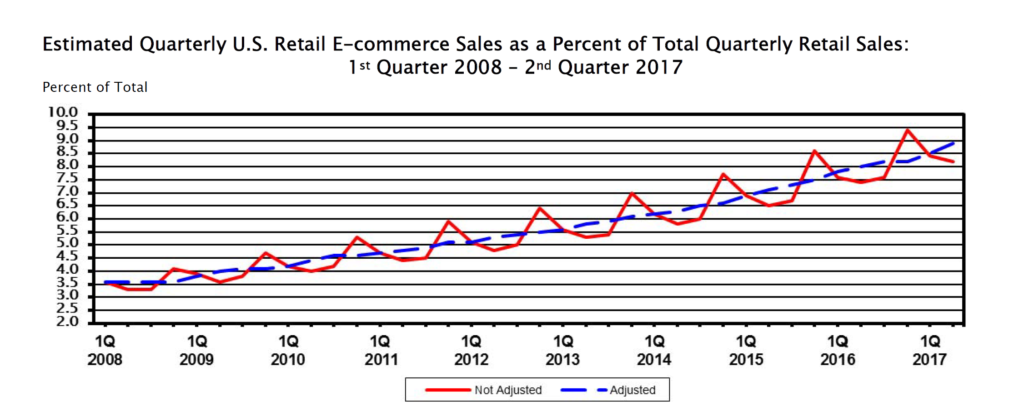
10 Nov QUARTERLY RETAIL E-COMMERCE SALES 2nd QUARTER 2017
THURSDAY, AUGUST 17, 2017, AT 10:00 A.M. EDT
Data Inquiries Economic Indicators Division, Retail Indicator Branch: (301) 763-2713 CB17-132 Media Inquiries Public Information Office: (301) 763-3030
QUARTERLY RETAIL E-COMMERCE SALES 2nd QUARTER 2017
What I find to be most interesting about this report is that, even with all the hype about Amazon, Ebay, etc., only 9% of U.S. residents are purchasing products online. That leaves a potential 91% of U.S. residents up for grabs as e-commerce customers.
If you thought that the e-commerce market is saturated, the numbers say something different. Read on for the official report and details.
The Census Bureau of the Department of Commerce announced today that the estimate of U.S. retail e-commerce sales for the second quarter of 2017, adjusted for seasonal variation, but not for price changes, was $111.5 billion, an increase of
4.8 percent (±0.9%) from the first quarter of 2017. Total retail sales for the second quarter of 2017 were estimated at $1,256.2 billion, an increase of 0.5 percent (±0.4%) from the first quarter of 2017. The second quarter 2017 e-commerce estimate increased 16.2 percent (±1.6%) from the second quarter of 2016 while total retail sales increased 4.1 percent (±0.5%) in the same period. E-commerce sales in the second quarter of 2017 accounted for 8.9 percent of total sales.
On a not adjusted basis, the estimate of U.S. retail e-commerce sales for the second quarter of 2017 totaled $105.1 billion, an increase of 6.9 percent (±0.9%) from the first quarter of 2017. The second quarter 2017 e-commerce estimate increased 16.3 percent (±1.6%) from the second quarter of 2016 while total retail sales increased 4.4 percent (±0.5%) in the same period. E-commerce sales in the second quarter of 2017 accounted for 8.2 percent of total sales.
Estimated Quarterly U.S. Retail E-commerce Sales as a Percent of Total Quarterly Retail Sales:
1st Quarter 2008 – 2nd Quarter 2017
Percent of Total
The Quarterly Retail E-Commerce sales estimate for the third quarter of 2017 is scheduled for release on November 17, 2017 at 10:00
A.M. EST.
For information, including estimates from 4th quarter 1999 forward, visit the Census Bureau’s Web site at
http://www.census.gov/retail. For additional information about Census Bureau e-business measurement programs and plans visit
* The 90% confidence interval includes zero. The Census Bureau does not have sufficient statistical evidence to conclude that the actual change is different from zero.
Table 1. Estimated Quarterly U.S. Retail Sales: Total and E-commerce1
(Estimates are based on data from the Monthly Retail Trade Survey and administrative records.)
| Quarter | Retail Sales (millions of dollars) | E-commerce as a Percent
of Total |
Percent Change From Prior Quarter | Percent Change From Same Quarter
A Year Ago |
|||
| Total | E-commerce | Total | E-commerce | Total | E-commerce | ||
| Adjusted2 | |||||||
| 2nd quarter 2017(p) | 1,256,232 | 111,542 | 8.9 | 0.5 | 4.8 | 4.1 | 16.2 |
| 1st quarter 2017(r) | 1,250,055 | 106,383 | 8.5 | 1.0 | 4.7 | 5.1 | 15.4 |
| 4th quarter 2016 | 1,237,663 | 101,606 | 8.2 | 1.7 | 1.7 | 3.8 | 14.2 |
| 3rd quarter 2016 | 1,216,808 | 99,870 | 8.2 | 0.9 | 4.0 | 2.1 | 15.4 |
| 2nd quarter 2016(r) | 1,206,395 | 96,014 | 8.0 | 1.4 | 4.2 | 2.3 | 15.2 |
| Not Adjusted | |||||||
| 2nd quarter 2017(p) | 1,274,565 | 105,096 | 8.2 | 9.5 | 6.9 | 4.4 | 16.3 |
| 1st quarter 2017(r) | 1,164,228 | 98,292 | 8.4 | -10.4 | -19.8 | 3.7 | 15.1 |
| 4th quarter 2016 | 1,299,699 | 122,515 | 9.4 | 6.5 | 32.2 | 3.6 | 14.0 |
| 3rd quarter 2016 | 1,220,051 | 92,644 | 7.6 | -0.1 | 2.5 | 2.2 | 15.5 |
| 2nd quarter 2016 | 1,220,714 | 90,397 | 7.4 | 8.8 | 5.8 | 2.2 | 15.6 |
(p) Preliminary estimate. (r) Revised estimate.
1 E-commerce sales are sales of goods and services where the buyer places an order, or the price and terms of the sale are negotiated over an Internet, mobile device (M-commerce), extranet, Electronic Data Interchange (EDI) network, electronic mail, or other comparable online system. Payment may or may not be made online.
2 Estimates are adjusted for seasonal variation, but not for price changes. Total sales estimates are also adjusted for trading-day differences and moving holidays.
Note: Table 2 provides estimated measures of sampling variability. For information on confidentiality protection, sampling error, nonsampling error, sample design, and definitions, see http://www.census.gov/retail/mrts/how_surveys_are_collected.html.
Table 2. Estimated Measures of Sampling Variability for Quarterly U.S. Retail Sales Estimates: Total and E-commerce
(Estimates are shown as percents and are based on data from the Monthly Retail Trade Survey.)
| Quarter | Coefficient of Variation (CV) | Standard Error1 (SE) for
E-commerce as a Percent of Total |
SE for
Percent Change From Prior Quarter |
SE for Percent Change
From Same Quarter A Year Ago |
|||
| Total | E-commerce | Total | E-commerce | Total | E-commerce | ||
| 2nd quarter 2017(p) | 0.7 | 1.5 | 0.1 | 0.2 | 0.5 | 0.3 | 0.9 |
| 1st quarter 2017(r) | 0.6 | 1.7 | 0.1 | 0.2 | 0.4 | 0.3 | 1.1 |
| 4th quarter 2016 | 0.5 | 1.4 | 0.1 | 0.1 | 0.5 | 0.4 | 1.0 |
| 3rd quarter 2016 | 0.5 | 1.7 | 0.1 | 0.2 | 0.6 | 0.4 | 1.1 |
| 2nd quarter 2016 | 0.5 | 1.6 | 0.1 | 0.2 | 0.5 | 0.3 | 1.0 |
(p) Preliminary estimate. (r) Revised estimate. (Z) Estimate is less than 0.05%.
1Standard errors may be larger than those previously published because the estimated totals used to produce the percent changes are derived from different samples.
Note: Estimated measures of sampling variability are based on data not adjusted for seasonal variation, trading-day differences, or moving holidays, and are used to make confidence statements about both adjusted and not adjusted estimates. For information on confidentiality protection,sampling error, nonsampling error, sample design, and definitions, see http://www.census.gov/retail/mrts/how_surveys_are_collected.html.
Survey Description
Retail e-commerce sales are estimated from the same sample used for the Monthly Retail Trade Survey (MRTS) to estimate preliminary and final U.S. retail sales. Advance U.S. retail sales are estimated from a subsample of the MRTS sample that is not of adequate size to measure changes in retail e-commerce sales.
A stratified simple random sampling method is used to select approximately 10,000 retail firms excluding food services whose sales are then weighted and benchmarked to represent the complete universe of over two million retail firms. The MRTS sample is probability based and represents all employer firms engaged in retail activities as defined by the North American Industry Classification System (NAICS). Coverage includes all retailers whether or not they are engaged in e-commerce. Online travel services, financial brokers and dealers, and ticket sales agencies are not classified as retail and are not included in either the total retail or retail e-commerce sales estimates. Nonemployers are represented in the estimates through benchmarking to prior annual survey estimates that include nonemployer sales based on administrative records. E-commerce sales are included in the total monthly sales estimates.
The MRTS sample is updated on an ongoing basis to account for new retail employer businesses (including those selling via the Internet), business deaths, and other changes to the retail business universe. Firms are asked each month to report e-commerce sales separately. For each month of the quarter, data for nonresponding sampling units are imputed from responding sampling units falling within the same kind of business and sales size category or based on historical performance of that company.
Responding firms account for approximately 72 percent of the e-commerce sales estimate and about 71 percent of the estimate of
U.S. retail sales for any quarter.
For each month of the quarter, estimates are obtained by summing weighted sales (either reported or imputed). The monthly estimates are benchmarked to prior annual survey estimates. Estimates for the quarter are obtained by summing the monthly benchmarked estimates. The estimate for the most recent quarter is a preliminary estimate. Therefore, the estimate is subject to revision. Data users who create their own estimates using data from this report should cite the Census Bureau as the source of the input data only.
Adjusted Estimates
This report publishes estimates that have been adjusted for seasonal variation and holiday and trading-day differences, but not for price changes. We used quarterly e-commerce sales estimates for 4th quarter 1999 to the current quarter as input to the X-13ARIMA-SEATS program to derive the adjusted estimates. For sales, we derived quarterly adjusted estimates by summing adjusted monthly sales estimates for each respective quarter. Seasonal adjustment of estimates is an approximation based on current and past experiences.
The X-13ARIMA-SEATS software improves upon the X-12 ARIMA seasonal adjustment software by providing enhanced diagnostics as well as incorporating an enhanced version of the Bank of Spain’s SEATS (Signal Extraction in ARIMA Time Series) software, which uses an ARIMA model-based procedure instead of the X-11 filter-based approach to estimate seasonal factors. The X-13ARIMA-SEATS and X-12 ARIMA software produce identical results when using X-13ARIMA- SEATS with the X-11 filter-based adjustments. The X-13ARIMA-SEATS software and additional information on the X- 13ARIMA-SEATS program may be found at http://www.census.gov/srd/www/x13as/.
Note that the retail estimates continue to be adjusted using the X-11 filter-based adjustment procedure. Reliability of Estimates
Because the estimates in this report are based on a sample survey, they contain sampling error and nonsampling error.
Sampling error is the difference between the estimate and the result that would be obtained from a complete enumeration of the population conducted under the same survey conditions. This error occurs because only a subset of the entire population is measured in a sample survey. Standard errors and coefficients of variation, as given in Table 2 of this report, are estimated measures of sampling variation.
The margin of error, as used on page 1, gives a range about the estimate which is a 90 percent confidence interval. If, for example, the estimated percent change is -11.4% and its estimated standard error is 1.2%, then the margin of error is
±1.753 x 1.2% or 2.1%, and the 90 percent confidence interval is -13.5% to -9.3%. Confidence intervals are computed based on the particular sample selected and canvassed. If one repeats the process of drawing all possible samples and forming all corresponding confidence intervals, approximately 90 percent of these individual confidence intervals would contain the estimate computed from a complete enumeration of all units on the sampling frame. If the confidence interval contains 0%, then one does not have sufficient evidence to conclude at the 90 percent confidence level that the change is different from zero.
Nonsampling error encompasses all other factors that contribute to the total error of a sample survey estimate. This type of error can occur because of nonresponse, insufficient coverage of the universe of retail businesses with e-commerce sales, mistakes in the recording and coding of data, and other errors of collection, response, coverage, or processing.
Although not directly measured, precautionary steps are taken to minimize the effects of nonsampling error.
Original post published here: http://azcwebservices.com/index.php/blog/569-quarterly-retail-e-commerce-sales-2nd-quarter-2017




Sorry, the comment form is closed at this time.